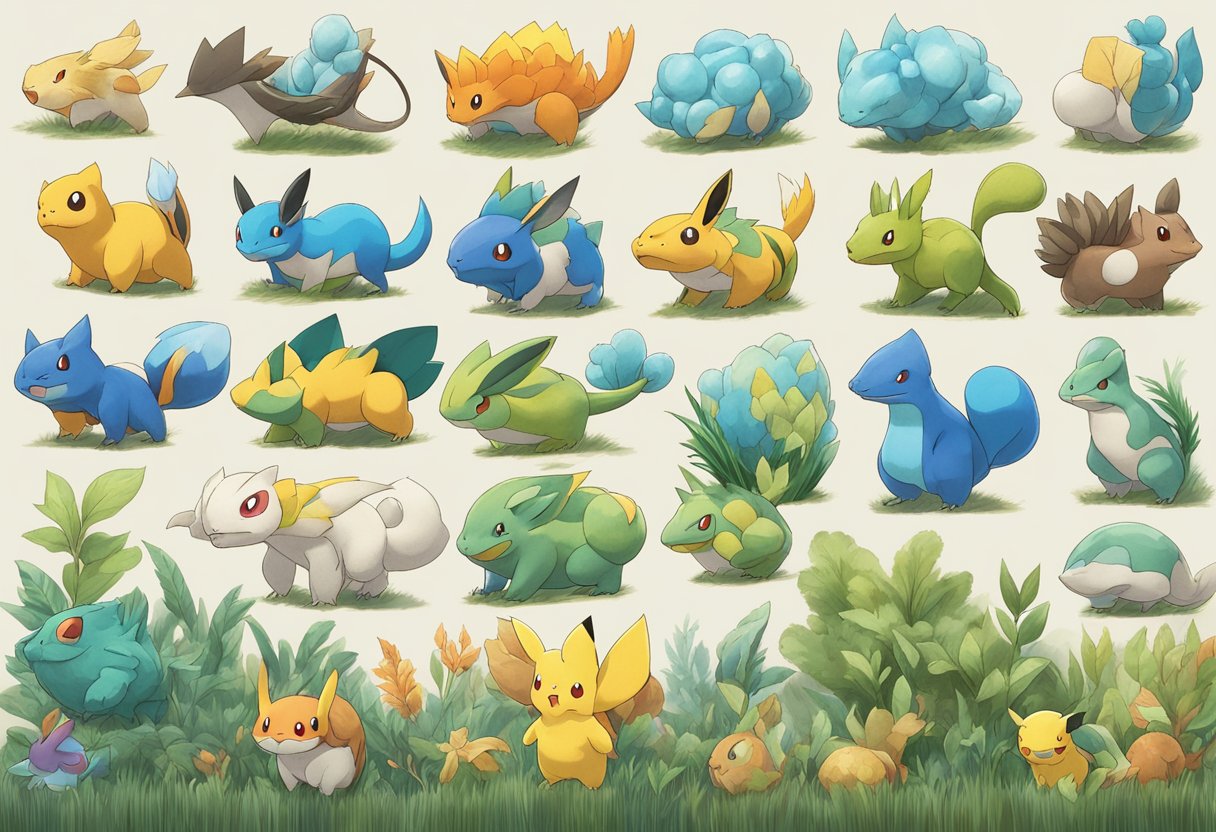Types Of Pokemon
Types of Pokemon refer to the various categories of Pokemon that exist in the world of Pokemon. There are currently 19 official types of Pokemon, each with their own unique characteristics and abilities. These types include Normal, Fire, Water, Electric, Grass, Ice, Fighting, Poison, Ground, Flying, Psychic, Bug, Rock, Ghost, Dragon, Dark, Steel, Fairy, and Stellar.
The concept of Pokemon types was first introduced in the original Pokemon games, and has since become an integral part of the franchise. Each type has its own strengths and weaknesses, which can be used to gain an advantage in battle. For example, Water-type Pokemon are strong against Fire-type Pokemon, while Electric-type Pokemon are strong against Water-type Pokemon.
Understanding the different types of Pokemon is essential for any serious Pokemon trainer. By knowing the strengths and weaknesses of each type, trainers can build a well-rounded team of Pokemon that can handle any challenge. In the following sections, we will explore the historical overview of Pokemon types, the mechanics of Pokemon types, and the distinct characteristics of each type.
Key Takeaways
- There are 19 official types of Pokemon, each with their own unique characteristics and abilities.
- Understanding the strengths and weaknesses of each type is essential for building a well-rounded team of Pokemon.
- The concept of Pokemon types was first introduced in the original Pokemon games and has since become an integral part of the franchise.
Historical Overview of Pokémon Types

Origins and Evolution
Since the introduction of the first generation of Pokémon, the concept of Pokémon types has been an integral part of the game. In Generation I, there were a total of fifteen types, including Normal, Fire, Water, Electric, Grass, Ice, Fighting, Poison, Ground, Flying, Psychic, Bug, Rock, Ghost, and Dragon. These types were designed to create a balance of strengths and weaknesses between the different Pokémon species, making gameplay more challenging and strategic.
As the Pokémon franchise evolved and new generations were introduced, the types of Pokémon also evolved. In later generations, new types were introduced to add even more variety to gameplay. For example, the Dark and Steel types were introduced in Generation II, the Fairy type was introduced in Generation VI, and the Stellar type was introduced in Generation IX.
Introduction of New Types in Later Generations
The introduction of new types in later generations has had a significant impact on the gameplay and strategy of Pokémon battles. For example, the Fairy type was introduced in Generation VI to counter the dominance of Dragon-type Pokémon, which were previously considered overpowered. The Stellar type, introduced in Generation IX, is a unique type that is only available to certain Legendary Pokémon.
In addition to new types, later generations have also introduced new moves and abilities that have further expanded the strategic possibilities of Pok√©mon battles. For example, the move “Fairy Wind” was introduced in Generation VI, which is a powerful Fairy-type move that can be used to deal damage to opponents.
Overall, the evolution of Pokémon types has been a key factor in the ongoing success and popularity of the franchise. With each new generation, players are presented with new challenges and opportunities to explore the world of Pokémon in new and exciting ways.
Pokémon Type Mechanics
Type Effectiveness Chart
Each Pokémon has one or two types, and each type has its own strengths and weaknesses. The type effectiveness chart shows how much damage a move will do against a Pokémon of a certain type. There are three possible outcomes: super-effective, not very effective, or no effect.
When a move is super-effective, it will do double the damage. When a move is not very effective, it will do half the damage. When a move has no effect, it will do no damage at all.
The type effectiveness chart is an important tool for trainers to use when planning their battles. It allows them to choose the best moves to use against their opponents and avoid using moves that will be ineffective.
STAB and Type Advantage
STAB stands for Same Type Attack Bonus. When a Pokémon uses a move that is the same type as itself, it will receive a 50% bonus to the damage it deals. This means that a move that would normally do 100 damage will do 150 damage if the Pokémon using it is the same type as the move.
Type advantage is when a Pok√©mon’s type gives it an advantage over its opponent. For example, a Fire-type move will be super-effective against a Grass-type Pok√©mon. This means that the Fire-type move will do double the damage it would normally do.
Type Matchups in Battles
Knowing the type matchups in battles is crucial for trainers. It allows them to choose the best Pokémon to use in a battle and the best moves to use against their opponent.
For example, a Water-type Pokémon will have an advantage over a Fire-type Pokémon. This is because Water-type moves are super-effective against Fire-type Pokémon.
In summary, understanding the type mechanics of Pokémon is essential for any trainer looking to become a master. By using the type effectiveness chart, taking advantage of STAB and type advantage, and knowing the type matchups in battles, trainers can gain the upper hand and emerge victorious.
Distinct Characteristics of Types
When it comes to Pokemon, each type has its own set of distinct characteristics that make them unique. In this section, we will explore some of the most notable features of Pokemon types.
Physical and Special Attributes
One of the most significant characteristics of Pokemon types is their physical and special attributes. Physical moves, such as Tackle or Slash, rely on a Pokemon’s Attack stat, while special moves, such as Flamethrower or Thunderbolt, rely on a Pokemon’s Special Attack stat. This means that some types, such as Fire and Electric, tend to have a higher Special Attack stat, while others, such as Fighting and Ground, tend to have a higher Attack stat.
Furthermore, some types are more resistant to physical attacks, such as Rock and Steel, while others are more resistant to special attacks, such as Psychic and Ghost. Understanding these physical and special attributes can be crucial when it comes to building a balanced team and selecting moves that will be most effective against certain types.
Status Effects and Abilities
In addition to physical and special attributes, Pokemon types also have unique status effects and abilities. For example, Poison-type moves can inflict the Poison status condition, which slowly drains a Pokemon’s HP over time. Meanwhile, Electric-type moves can paralyze a Pokemon, causing them to occasionally be unable to attack.
Abilities are also an essential aspect of Pokemon types. Each type has its own set of abilities, some of which can be incredibly useful in battle. For example, the Water-type ability, Water Absorb, allows a Pokemon to heal HP when hit by a Water-type move. Understanding the various status effects and abilities of each type can help trainers make informed decisions when it comes to selecting Pokemon for their team.
Overall, understanding the distinct characteristics of Pokemon types is crucial for any trainer looking to build a successful team. By considering a type’s physical and special attributes, as well as its unique status effects and abilities, trainers can create a well-rounded team capable of taking on any challenge.
Type-Specific Pokémon Examples
Iconic Pokémon of Each Type
Each type of Pokémon has its own iconic Pokémon that represents it. For example, Pikachu is the most well-known Electric-type Pokémon, while Bulbasaur is the most iconic Grass/Poison-type Pokémon. Eevee is a unique Pokémon that can evolve into multiple different types, making it a popular and versatile choice for trainers.
Water-type Pokémon are among the most common and popular in the game, and Empoleon is a great example of a strong Water/Steel-type Pokémon. It has high defense and special attack stats, making it a great choice for battles.
Dual-Type Pokémon Strategies
Dual-type Pokémon are those that have two different types, which can make them both versatile and challenging to battle against. Scyther is a popular example of a dual-type Pokémon, being both a Bug and Flying-type. Its high speed and attack stats make it a formidable opponent.
Klefki is another unique dual-type Pokémon, being both a Fairy and Steel-type. Its ability to set up traps and use moves like Spikes and Toxic Spikes make it a great choice for strategic battles.
Azurill and Marill are both Water/Fairy-type Pokémon that are known for their high HP and special defense stats. Cubone and Marowak are Ground-type Pokémon that are known for their high attack stats and unique moves like Bone Club and Bonemerang.
Overall, understanding the strengths and weaknesses of each type of Pokémon, as well as the strategies that work best for dual-type Pokémon, can help trainers build a strong and versatile team.
Pokémon Types in Gaming and Media
Pokémon types play a crucial role in the world of Pokémon, and they have been a defining feature of the franchise since the very beginning. In this section, we will explore the various ways in which types are used across different forms of Pokémon media.
Main Series and Spin-Off Games
The Pokémon games are the most prominent form of media that feature types. Each Pokémon has one or two types, which determine their strengths and weaknesses in battle. The games also feature a type chart, which shows the effectiveness of each type against other types. This chart has changed over time, with new types being added and existing types being adjusted for balance.
Spin-off games, such as Pokémon Mystery Dungeon and Pokémon Ranger, also make use of types in their gameplay mechanics. In these games, types affect the damage dealt and received by Pokémon, and players must strategize accordingly.
Trading Card Game
The Pok√©mon Trading Card Game is another popular form of media that features types. Each card represents a Pok√©mon with one or two types, and these types determine the card’s strengths and weaknesses. The card game also features a type chart, which works similarly to the one in the main series games.
Pokémon Go and Mobile Adaptations
Pokémon Go is a mobile game that has taken the world by storm. In this game, players catch Pokémon in the real world using their smartphones. Types play a significant role in Pokémon Go, affecting which Pokémon spawn in different locations and how effective they are in battle.
Other mobile adaptations of Pokémon, such as Pokémon Duel and Pokémon Masters, also make use of types in their gameplay mechanics.
Overall, types are a fundamental aspect of the Pokémon franchise, and they play a crucial role in its gameplay mechanics and lore. Whether you are playing the main series games, collecting trading cards, or catching Pokémon in the real world, understanding types is essential for success.






